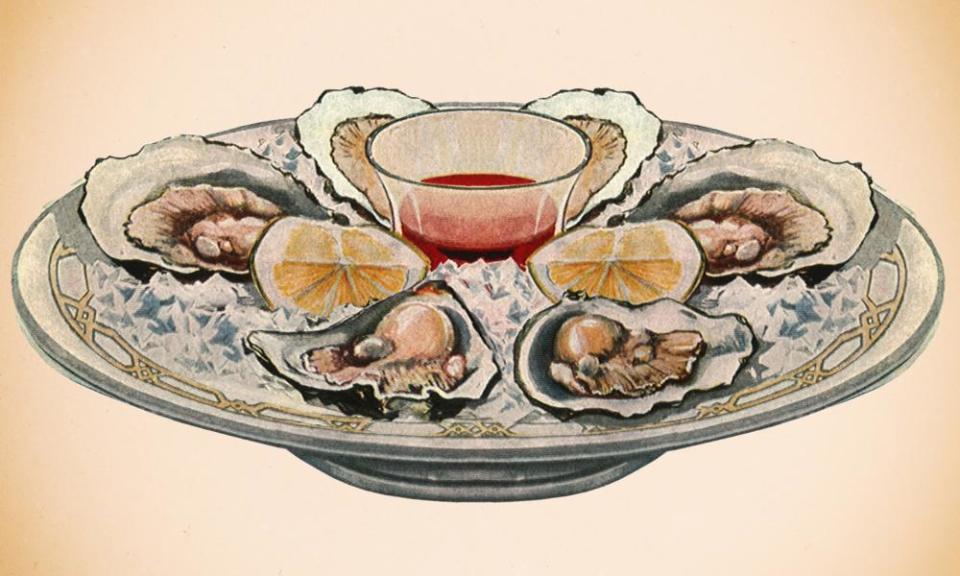An oyster: they can hear the breaking waves

On the oyster’s edge, under the sea, on a rock, a tree root, a bamboo pole, a pebble, a tile or another shell, the bivalve’s cilia – from the Latin for eyelash – are waving. Together, they move water over the oyster’s gills – its shell is open, its muscles are relaxed. The oyster has lungs. It has a three-chambered heart. An hour passes; the oyster has filtered five litres of water. The oyster has listened to the breaking waves: it opens and closes according to the tides.
One valve is the cupped half of the shell, the other is the flat half. A cargo ship sounds its horn. The oyster shuts in fright.
Above the water, in Lewis Carroll’s Through the Looking Glass, the Walrus and the Carpenter are “walking close at hand”. The sun is shining in the middle of the night. The moon has opinions about this. (In the Disney cartoon, the sinister Walrus and the Carpenter stroll between two halves of a screen: one light, one dark. The Walrus spins his cane).
They come upon the oysters, the oysters come along. “Their coats were brushed, their faces washed / Their shoes were clean and neat / And this was odd, because, you know / They hadn’t any feet.”
When oysters spawn (they decide on when to prepare to do so by listening for thunderstorms and rain) the larvae are mobile. They can swim vertically, which they do for two weeks, chasing phytoplankton. Then (contrary to the poem) they develop a foot, which finds something to attach to, and they give up moving forever – unlike a clam, for example, which can continue to shift around the mud.
“Those two weeks are his one taste of vagabondage, of devil-may-care free roaming,” wrote MFK Fisher in Consider the Oyster. Now the oyster is called a spat and it starts to build its shell.
“The two fine free-swimming weeks are gone forever, maturity with all its cares has come … For about a year this oyster – our oyster – is a male,” wrote Fischer. “Then one day, maternal longings surge between his two valves in his cold guts and gills and all his crinkly fringes. Necessity, that well-known mother, makes him one. He is a she.”
When the oyster is at least two years old, we eat it. In A Christmas Carol, Scrooge’s room fills with “barrels of oysters, red-hot chestnuts, cherry-cheeked apples, juicy oranges, luscious pears, immense twelfth-cakes, and seething bowls of punch, that made the chamber dim with their delicious steam”. In Anton Chekhov’s story Oysters, a boy who has never seen one imagines “a frog sitting in a shell, peeping out from it with big, glittering eyes, and moving its revolting jaws”. In James Joyce’s Ulysses, Leopold Bloom “walks on a net, covers his left eye with his left ear, passes through several walls, climbs Nelson’s Pillar, hangs from the top ledge by his eyelids, eats 12 dozen oysters (shells included)”.
To eat an oyster raw is to eat it alive. What does it hear as you prepare to slip its body down your throat? If you don’t bite into it, does it start to hear your heartbeat as it moves past your breastbone?
You are on holiday, eating oysters. The conversation moves to pearls. Maybe Joanna Newsom’s Divers is playing in the seaside restaurant: “I dream it every night / the ringing of the pail, the motes of sand dislodged, the shucking, quick and bright / the twinned and cast-off shells reveal a single heart of white,” she sings.
You eat another. Your lips pucker from the vinegar, you swallow some white wine – does the oyster hear the waves one last time as the drink splashes after it?
• “The Nature of … ” is a column by Helen Sullivan dedicated to interesting animals, insects, plants and natural phenomena. Is there an intriguing creature or particularly lively plant you think would delight our readers? Let us know on Twitter @helenrsullivan or via email: helen.sullivan@theguardian.com

 Yahoo Finance
Yahoo Finance 